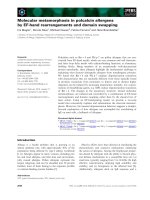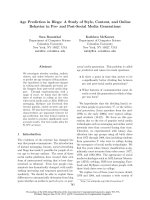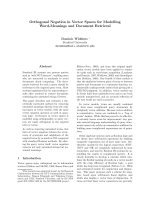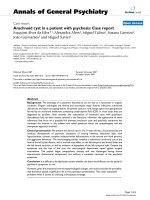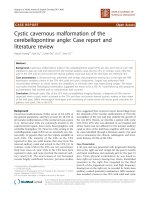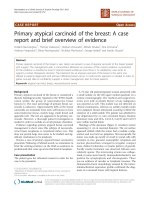Báo cáo khoa học: "Spontaneous regression in alveolar soft part sarcoma: case report and literature review" pps
Bạn đang xem bản rút gọn của tài liệu. Xem và tải ngay bản đầy đủ của tài liệu tại đây (650.94 KB, 4 trang )
BioMed Central
Page 1 of 4
(page number not for citation purposes)
World Journal of Surgical Oncology
Open Access
Case report
Spontaneous regression in alveolar soft part sarcoma: case report
and literature review
Mohammed N BaniHani* and Abdel Rahman A Al Manasra
Address: King Abdullah University Hospital, Department of Surgery, Jordan University of Science and Technology, Irbid, Jordan
Email: Mohammed N BaniHani* - ; Abdel Rahman A Al Manasra -
* Corresponding author
Abstract
Background: Sarcomas are a type of malignant tumors that arise from connective tissue. They are
most of the time found in extremities
Case presentation: We are presenting a case of adult male patient, who was found to have huge
abdominal mass and multiple gastric and duodenal polyps. Pathological diagnosis for all lesions was
Alveolar soft part sarcoma. Although he complained from metastasis to both lungs and right atrium,
all these deposits regressed spontaneously. Patient stated that he used some herbs (Teucrium
polium, Cat Thyme) prescribed for him. No chemotherapy or radiotherapy was given. The duration
of regression was about 5 months before other lesions appeared. Later on, he died secondary to
brain metastasis.
Conclusion: ASPS is a rare type of sarcomas that affect primarily the lower limbs. This tumor does
rarely metastasize to the gastrointestinal tract.
Background
Sarcomas are a type of malignant tumors that arise from
connective tissue. They are most of the time found in
extremities. The term -Soft Part- is used to distinguish
these sarcomas from bone sarcomas. Although soft tissue
sarcomas are linked to the tissue of origin; alveolar
description is based on the histological pattern of the
tumor rather than the origin.
Case presentation
A 38 year old male married patient, medically free,
referred to our center from a another hospital complain-
ing from lower abdominal pain of few months duration,
intermittent, vague, gripping in nature, associated with
abdominal distention.
He didn't undergo any type of surgery previously. Past his-
tory of the patient was negative for any fever, sweating,
vomiting, constipation, or weight changes. He also didn't
suffer from obstructive urinary symptoms. Family history
was negative too.
On examination, he actually was found to have large left,
hypochondrial mass. It was painless & hard in consist-
ency.
On investigation, his hemoglobin level and leukocytic
count were within normal range. Markers for colon, liver
and prostate cancers were negative. On computerized
tomographic (CT) scan; there was a large heterogeneous
mass measuring about 16 × 12 × 10 cm occupying the left
Published: 10 June 2009
World Journal of Surgical Oncology 2009, 7:53 doi:10.1186/1477-7819-7-53
Received: 11 March 2009
Accepted: 10 June 2009
This article is available from: />© 2009 BaniHani and Al Manasra; licensee BioMed Central Ltd.
This is an Open Access article distributed under the terms of the Creative Commons Attribution License ( />),
which permits unrestricted use, distribution, and reproduction in any medium, provided the original work is properly cited.
World Journal of Surgical Oncology 2009, 7:53 />Page 2 of 4
(page number not for citation purposes)
hypochondrial region with multiple small metastatic right
lung lesions (figures 1 &2). CT guided fine needle aspira-
tion was performed and was positive for malignancy. At
that time, patient was offered surgical intervention for the
abdominal mass but he refused any further treatment.
Upon follow up of the patient, CT scan was repeated 7
months later, there were multiple bilateral lung deposits
the largest measuring about 1 cm in diameter. Also there
was a large tumor in left atrium (figure 3) extending to
inferior left pulmonary vein measuring about 2 cm. the
mass in the abdomen was still there as before. Then
patient was sent home for tender care upon his request.
Five months spent at home and the man came back again.
He just reported a better feeling than before upon using
some herbs (Teucrium polium, Cat Thyme) prescribed for
him. On examination; there was no masses felt in the
abdomen, so that CT scan was repeated. Unexpectedly;
there was more than 60% reduction in the tumor size as
well as disappearance of lungs & heart lesions as illus-
trated by figures 4 &5. During this interval, he was not
given any type of radiation or chemicals as a therapy for
his illness. Surgery was offered again and the mass
removed by laparoscopic approach. Histopathologic anal-
ysis described a rounded hemorrhagic, necrotic and par-
tially hyalized tumor that is markedly vascular and has a
very prominent alveolar pattern. Immunohistochemical
staining including cytokeratin, desmin, actin, S-100, syn-
aptophysin, HMB45, chromogranin, vimentin,
myoglobin and PAS was performed. All stains were nega-
tive apart from PAS and myoglobin which were positive
(figure 6). The overall picture was consistent with alveolar
soft part sarcoma (ASPS) infiltrating the omentum. Simi-
larly, endoscopic assessment of upper gastrointestinal
tract (due to epigastric pain) demonstrated multiple ses-
sile polyps in stomach & duodenum; biopsies were taken,
and the diagnosis was alveolar soft part sarcoma. Few
months' later, patient developed headaches, brain CT scan
was done and unfortunately he was found to have meta-
static brain lesions. He was referred to a specialized center
for radiotherapy and died within 6 months.
Discussion
ASPS is a rare type of sarcomas, accounting for less than
1% of soft tissue sarcomas [1]. It was firstly described by
Christopherson et al in 1952 [2]. The usual age for presen-
tation is 15–35 years. The most common site for the
tumor is lower extremities [3], representing about 60% of
ASPS cases. Other sites included are head and neck, more
commonly in children.
Large abdominal massFigure 1
Large abdominal mass.
Lung metastasisFigure 2
Lung metastasis.
Atrial lesionFigure 3
Atrial lesion.
World Journal of Surgical Oncology 2009, 7:53 />Page 3 of 4
(page number not for citation purposes)
It has been reported that certain organs can be very unu-
sually targeted by ASPS malignant cells. Part of the list
includes female genital tracts, breasts and mediastinum.
[4-7]
Gastrointestinal tract is also rarely involved by these
malignancies. Only 3 cases were reported. In 2001,
Michael S.et al reported a case of ASPS metastatic to small
bowel mucosa causing polyposis and intussuseption in a
42 year old male with long history of ASPS metastasis to
lungs and brain. [3] Later on; in 2003, Zilber S. et al
reported another 43 year old woman who had a leg pri-
mary tumor more than 15 years ago and multiple lung
and brain metastases. She also was found to have caecal
metastases, revealed by an anemia, she was treated by
laparoscopic right colectomy [8]. Primary Gastrointestinal
ASPS is extremely rare. Only one case was reported in
2000 by Yaziji H et al. He described a Primary ASPS of the
stomach in a 54 year old Italian woman without evidence
of primary neoplasm elsewhere ten years following the
initial diagnosis [9].
In our case, screening for primary lesions in extremities
was negative. Pathological wise, depending on the cellu-
larity of the tumor, the primary source is more likely to be
from mesenchymal cells of the mesentery than from gas-
tric or duodenal polyps,. This means that it can be consid-
ered the first case of this origin type to be reported in the
literature.
Spontaneous regression is a term that is used interchange-
ably with spontaneous remission. Tilden Everson and
Warren Cole have defined spontaneous regression of can-
cer as the partial or complete disappearance of a malig-
nant tumor in the absence of all treatment or in the
presence of therapy which is considered inadequate to
exert a significant influence on neoplastic disease. They
stated that it is not implied that spontaneous regression
need progress to complete disappearance of tumor nor
that spontaneous regression is synonymous with cure, all
cases in which a tumor underwent apparent spontaneous
regression in one area but flourished unchecked in other
areas or reappeared at a later date are considered as valid
examples of this phenomenon in their opinion. Until
now, this definition of spontaneous regression, with few
additions, has remained the one in most common usage
today [10]. In fact, what happened in our patient case
does fit to the criteria mentioned in their definition of
spontaneous regression.
Abdominal tumor regressionFigure 4
Abdominal tumor regression.
Lung and cardiac metastasis regressionFigure 5
Lung and cardiac metastasis regression.
Histologic viewFigure 6
Histologic view.
World Journal of Surgical Oncology 2009, 7:53 />Page 4 of 4
(page number not for citation purposes)
The highest incidence of this phenomenon was in tumors
of genitourinary organs. According to Caryle Hirshberg
[11], between 1918 and 1993, a total of 64 soft tissue sar-
comas cases were reported to undergo spontaneous
regression, however, spontaneous regression in the more
specific alveolar pattern sarcomas has not been identified
during that period.
To the best of our knowledge, only a single case of ASPS
with spontaneous regression (of pulmonary metastases)
has been published. In 2003, A 14 year old male patient
was described to have ASPS in femoral region. A com-
bined chemotherapy (radiotherapy, hyperthermia and
chemotherapy) was performed before operation. Tumor
wide resection was carried out, however, a metastatic
lesion revealed in the lung continued to increase in
number and size during the progress after operation, how-
ever, it decreased in size and number after several years
[12].
In 1988, Pang and colleagues have report a case of female
patient with ASPS who survived for over 9 years after
detection of pulmonary metastases regressed when she
was treated with oral and topical Chinese herbs. She had
excision of a right buttock mass in 1975. She was given
cytotoxic chemotherapy, but there was no radiological
response. Thereafter; she took herbal mixture from March
1979 to July 1982. Chest X-rays in 1983 showed complete
disappearance of some shadows and shrinkage of others.
[13]
In a study conducted by Kebudi R. et al between 1989 and
2002, the incidence of brain metastases in extracranial
solid tumors was studied in pediatric age group. Only 16
out of 1100 children with extracranial solid tumors devel-
oped brain mets. One of the 16 was found to be alveolar
soft part sarcoma. [14]
The aim of publishing our case, the second of its type in
the literature, was to encourage the study of biological
behavior of ASPS as well as common molecular character-
istics that could be present in other tumors that tend to
regress alone.
Conclusion
ASPS is a rare type of sarcomas that affect primarily the
lower limbs. This tumor does rarely metastasize to the gas-
trointestinal tract. We can only speculate on the unusual
spontaneous regression reported in this case. We do not
have any solid information of a cytotoxic effect of the herb
used, so we speculate that the regression was spontaneous
probably mediated by the immunologic system of the
host. However, this effect was short termed as the patient
has died from further progression and metastasis of the
tumor.
Consent
Written informed consent was obtained from the next of
kin for reporting of this case, the copy of consent is avail-
able with editor in chief.
Competing interests
The authors declare that they have no competing interests.
Authors' contributions
MB and ARA were involved in the concept and design,
preparation of draft and editing of final manuscript. Both
authors read and approved the final manuscript.
References
1. Enzinger FM, Weiss SW: Alveolar soft part sarcoma. In Soft Tissue
Tumors Volume 13. 3rd edition. St. Louis, MO: CV Mosby;
1995:1067-1074.
2. Christopherson WM, Foote FW Jr, Stewart FW: Alveolar softpart
sarcoma: structurally characteristic tumors of uncertain his-
togenesis. Cancer 1952, 5:100-111.
3. Portera CA Jr, Ho V, Patel SR, Hunt KK, Feig BW, Respondek PM,
Yasko AW, Benjamin RS, Pollock RE, Pisters PW: Alveolar soft part
sarcoma: clinical course and patterns of metastasis in 70
patients treated at a single institution. Cancer 2001,
91:585-591.
4. Sabel MS, Gibbs JF, Litwin A, McGrath B, Kraybill WB, Brooks JJ:
Alveolar soft part sarcoma metastatic to small bowel
mucosa causing polyposis and intussuseption. Sarcoma 2001,
5:133-137.
5. Nielsen GP, Oliva E, Young RH: Alveolar soft-part sarcoma of
the female genital tract: a report of nine cases and review of
the literature. Int J Gynecol Pathol 1995, 14(4):283-92.
6. Radig K, Buhtz P, Roessner A: Alveolar soft part sarcomaof the
uterine corpus. Report of two cases and review of the litera-
ture. Pathol Res Pract 1998, 194(1):59-63.
7. Flieder DB, Moran CA, Suster S: Primary alveolar soft-part sar-
coma of the mediastinum: a clinicopathological and immu-
nohistochemical study of two cases. Histopathology 1997,
31(5):469-73.
8. Zilber S, Brouland JP, Voisin MC, Ziza JM, Desplaces N, Chekulaev D,
Hobeika J, Houdart R: Colic metastases of alveolar soft-part
sarcoma: A case report and review of the literature. Ann
Diagn Pathol 2003, 7(5):306-9.
9. Yaziji H, Ranaldi R, Verdolini R, Morroni M, Haggitt R, Bearzi I: Pri-
mary alveolar soft part sarcoma of the stomach: a case
report and review. Pathol Res Pract 2000, 196(7):519-25.
10. Everson TC: Spontaneous regression of cancer. Ann N YAcad Sci
1964, 114:721-35.
11. Hirshberg C:
Spontaneous Remission. The Spectrum of Self-Repair
1993 [ />].
12. Iwao S, Takanobu O, Masato Y, Fumiaki K, Yoshihiro S, Toyoaki T:
Alveolar soft part sarcoma with spontaneous regression of
pulmonary metastases. Clinical Orthopedic Surgery 2003,
38:839-841.
13. Pang JA, Yeung TF, Cockram CS: Alveolar soft-part sarcoma: a
hormone-sensitive tumour? Postgrad Med J 1988, 64:386-388.
14. Kebudi R, Ayan I, Görgün O, Ağaoğlu FY, Vural S, Darendeliler E:
Brain metastasis in pediatric extracranial solid tumors: sur-
vey and literature review. J Neurooncol 2005, 71:43-48.
